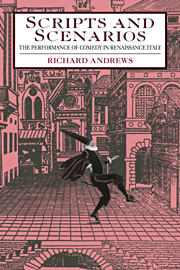Book contents
- Frontmatter
- Contents
- Preface
- Introduction: Italy in the sixteenth century
- 1 Precedents
- 2 The first ‘regular’ comedies
- 3 The second quarter-century, outside Venice
- 4 The second quarter-century, Venice and Padua
- 5 Improvised comedy
- 6 Obstacles to comedy
- 7 Scripts and scenarios
- Notes
- Chronological bibliography of comedies, 1500–1560
- General bibliography
- Index
2 - The first ‘regular’ comedies
Published online by Cambridge University Press: 29 October 2009
- Frontmatter
- Contents
- Preface
- Introduction: Italy in the sixteenth century
- 1 Precedents
- 2 The first ‘regular’ comedies
- 3 The second quarter-century, outside Venice
- 4 The second quarter-century, Venice and Padua
- 5 Improvised comedy
- 6 Obstacles to comedy
- 7 Scripts and scenarios
- Notes
- Chronological bibliography of comedies, 1500–1560
- General bibliography
- Index
Summary
REVIVALS OF ROMAN COMEDY
The most natural public for Roman comedy in the original was to be found in an academic environment, among those who taught and studied the texts as part of the humanist educational package. It is likely therefore that there were many university performances of the plays, including unrecorded ones as well as those which we know about. University theatre was in any case an extensive phenomenon in the fifteenth century. As well as revivals, it involved the composition of original works in Latin: ‘humanist comedy’ which often had very little in common with the Roman models, to the extent of failing to observe any unity of place or time, ignoring the five-act structure, and dealing with subjects far from the family-based intrigues of Plautus and Terence.
The dramaturgy of original humanist comedy can be interesting and even effective, but the whole phenomenon was too esoteric to influence court or public theatre in the vernacular. (It might at most have left its mark on two eccentric and slightly mysterious comedies of the sixteenth century: Agostino degli Pennacchi's La Perugina, published in 1526, and the more celebrated anonymous La Veniexiana currently dated at 1536.) Student revivals of Roman comedy were eventually of more importance. They helped to disseminate the view that acting on stage, in strictly all-male casts, could be a good training in public speaking and deportment (both essential features of humanist education) and thus might not be ruled out as a pastime for young gentlemen.
Information
- Type
- Chapter
- Information
- Scripts and ScenariosThe Performance of Comedy in Renaissance Italy, pp. 31 - 63Publisher: Cambridge University PressPrint publication year: 1993
